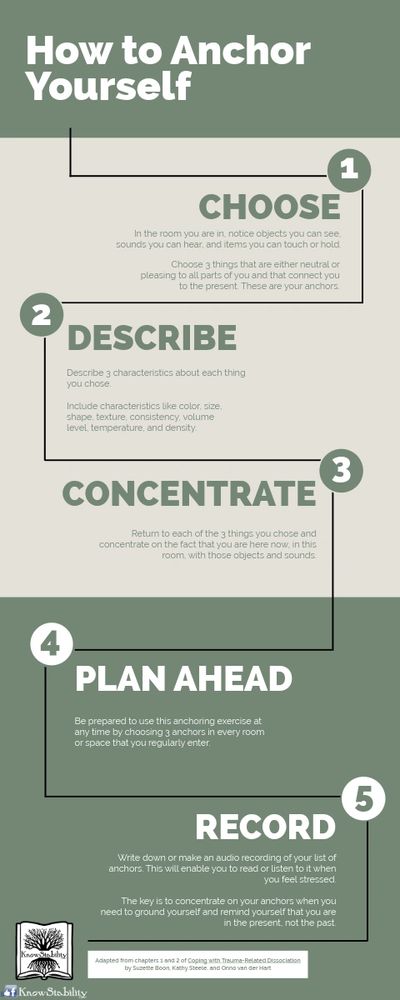Emotional Regulation Techniques for Autism with DID
A Mindful SNACK
Follow the acronym SNACK to learn this emotional regulation technique for your recovery process. As someone with autism, we love how concise this method is.
Your Window of Tolerance
Learning about your window of tolerance is a key lesson in emotional regulation and understanding it enhances all stabilization techniques.
Alternate Nostril Breathing
Alternate nostril breathing calms your parasympathetic nervous system and regulates your vagal signaling. This type of breathing is very helpful for autism and DID.
EMDR Meditations
Dr. Massimino's EMDR meditations are helpful emotional regulation techniques. "Meditation #2: Container & Safe Calm Place" is our favorite. Note: If you have aphantasia, these meditations may be difficult or impossible.
The Calm app
The Calm app
The Calm app contains many audio tracks that can be used to learn mindfulness and meditation to create emotional regulation.
Brain.fm
The Calm app
Sound can be an awesome way to create emotional regulation, especially if you have auditory sensitivity from autism.
Guided Meditations for Anxiety & Panic
Guided Meditations for Anxiety & Panic
These guided meditations on Audible by Belleruth Naparstek will help calm your anxiety and panic. Note: If you have aphantasia, some of these meditations may be difficult or impossible.
Guided Meditations for Healing Trauma
Guided Meditations for Anxiety & Panic
These guided meditations on Audible by Belleruth Naparstek are helpful for autism and PTSD. When she describes the "gentle loving beings," imagine that these are the other parts of your DID system. Note: If you have aphantasia, some of these meditations may be difficult or impossible.
DBT Skills Training
Dialectical Behavior Therapy (DBT) teaches many excellent emotional regulation skills and trauma stabilization techniques which are crucial if you have autism and DID.
Coping with Dissociation
Coping with Dissociation
This is an excellent resource for learning emotional regulation skills and it can help in your childhood trauma recovery process if you have DID.
Learn How To Anchor Yourself In the Present
A Better Grounding Exercise for Autism with Dissociative Identity Disorder
For those of us with autism and dissociative identity disorder, the typical 5-4-3-2-1 grounding technique is less helpful. We found that choosing anchors and completing Step 3 in this infographic make sensory grounding much more effective. Follow the 5 steps in this infographic to create a life anchored in the present. Feel free to save the image to your device and use it as a resource so that you can know stability.

Good Sleep Supports Emotional Regulation
Sleep Meditation to Feel Safe
Sleep Meditation for Hard Times
Sleep Meditation for Hard Times
Better sleep helps maintain emotional regulation and leads to trauma stabilization. Listen to feel safe while you enter deepest sleep.
Sleep Meditation for Hard Times
Sleep Meditation for Hard Times
Sleep Meditation for Hard Times
Maintain emotional regulation by getting good sleep,. Use this meditation to sleep when your recovery process is too hard.
Sleep Stories & Sleep Mediations
The Calm app has a multitude of sleep stories and sleep meditations that will help you fall asleep.
Guided Meditation for Healthful Sleep
This guided meditation on Audible by Belleruth Naparstek helps with emotional regulation to aid you in falling asleep. It works even if you have both autism and DID and is duplicated with a shorter musical ending in her "Three Stages of Healing Trauma." Note: If you have aphantasia, parts of this meditation may be difficult or impossible.
Dealing with Sensory Overload from Autism
Do You Have Sensory Overload?
If you have autism and DID, you probably experience sensory overload. Learn more about it and how to cope.
The Importance of Stimming
If you have autism and DID, stimming is essential for emotional regulation.
Proprioceptive Sensory Diet
With autism and DID, a sensory diet is key. This article lists many ways to calm yourself using proprioceptive activities.
Tappy
Tappy is a fun app that helps with sensory overload. Download it to help you self-regulate if you have autism.
Copyright © 2025 KnowStability - All Rights Reserved.








